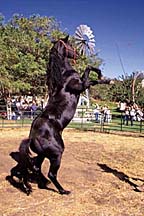American Quarter Horse
N/A
Tue, 19th November, 2024 - 9:30 am GMT
Sponsor Ads:

Alternative Name
N/ABasic Info
Since the creation of the American Quarter Horse Association more than 50 years ago, breeders have been perfecting the bloodlines of the American Quarter Horse to produce a high quality, versatile animal. AQHA has set forth a strict set of guidelines regarding registration of American Quarter Horses. American Quarter Horses are allowed only limited white markings on the face and below the knees. If you see white anywhere else in spots or patches, you're not looking at an American Quarter Horse. In addition, there are 13 accepted colors recognized by AQHA. The most prominent of these colors is sorrel (reddish brown), with the others being bay, black, brown, buckskin, chestnut, dun, red dun, gray, grullo, palomino, red roan and blue roan. The official gray color is what most people call white, but it's interesting to note that there are no "white" American Quarter Horses. Beyond their appearance, a registered American Quarter Horse foal (baby) is the product of a numbered American Quarter Horse dam (mare or mother) and a numbered American Quarter Horse sire (stallion or father). AQHA also offers an appendix registry for foals with one numbered American Quarter Horse parent and one Thoroughbred parent registered with The Jockey Club
Health
N/AHabitat
N/ABehavior
Identifiable characteristics of the breed are heavy muscling, sprinter's speed, versatility, keen cow sense and a gentle nature. From the past where the American Quarter Horse origins can be traced to ranching and racing, to the present where American Quarter Horses excel in a variety of events, the American Quarter Horse gives an individual many outlets for enjoyment, thus making it the world's most popular breedOrigin
United StatesHistory
The American Quarter Horse is the first breed of horse native to the United States. The breed evolved when the bloodlines of horses brought to the New World were mixed. Foundation American Quarter Horse stock originated from Arab, Turk and Barb breeds. Selected stallions and mares were crossed with horses brought to Colonial America from England and Ireland in the early 1600s. This combination resulted in a compact, heavily muscled horse that evolved to fill the colonist's passion for short-distance racing.Common Foods
grassSponsor Ads:
You can never entirely stop being what you once were. That's why it's important to be the right person today, and not put it off till tomorrow. -- Larry Wall
American Quarter Horse
Coded by: BGID® | ALL RIGHTS RESERVED Copyright © 2000-2024
Disclaimer | Privacy | Report Errors / Contact | Credits








 Politician, US Vice President and President of the USA - Joseph Robinette Biden Jr.
Politician, US Vice President and President of the USA - Joseph Robinette Biden Jr.  President of the United States of America - Real Estate mogul, Pageant owner and now one of the most controversial men in political history.
President of the United States of America - Real Estate mogul, Pageant owner and now one of the most controversial men in political history.  versus
versus  Russia: 'The Evil Empire'? Are they all that bad or is it just the USA trying to portray Russia as bad because they are a world power with land bigger and a society very different from the USA ideal?
Russia: 'The Evil Empire'? Are they all that bad or is it just the USA trying to portray Russia as bad because they are a world power with land bigger and a society very different from the USA ideal?  Global warming has been in and out as the "latest" hot topic for many years. It is, according to modern scientists, the result of man-made industrial pollutants, clearing forested areas, agriculture, etc. But now they are thinking it started way before the Industrial Revolution...
Global warming has been in and out as the "latest" hot topic for many years. It is, according to modern scientists, the result of man-made industrial pollutants, clearing forested areas, agriculture, etc. But now they are thinking it started way before the Industrial Revolution... 
 Corona virus
Corona virus 
 Users with wide screen monitors can benefit from more content on every page.
Users with wide screen monitors can benefit from more content on every page.